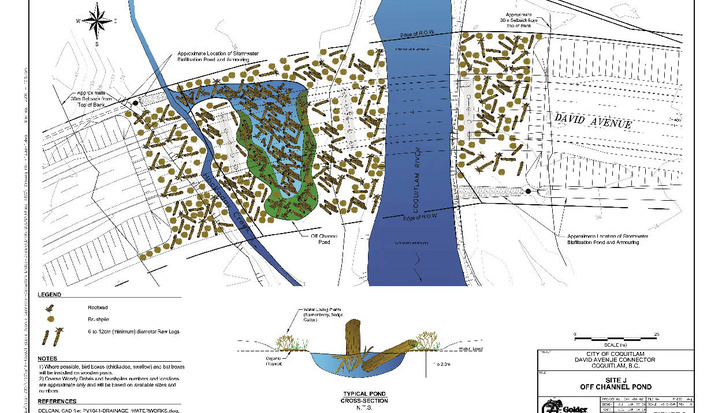
David Avenue Connector
|
|
Certifications & Awards
Project Team
- City of Coquitlam
- Greater Vancouver Transportation Authority (Translink)
- Delcan Corporation
- Golder Associates
Green Building Audio
 Targeting LEED Green Education Credit?
Targeting LEED Green Education Credit?Our audio tours qualify.
Get one today!
Summary
Key Sustainability Features:
- Stormwater Management: biofiltration swales, water quality pond, exfiltration (ground recharge) chamber
- Environmental compensation: off-channel rearing ponds, riparian plantings along Coquitlam River, Hyde Creek and Watkins Creeks, large woody debris structures in Coquitlam River, open-bottomed culverts and fish ladders at Watkins Creek, enhanced wildlife corridors, habitat to support re-listed species
The City of Coquitlam opened the David Avenue Connector (DAC) in August 2006. It is a 2 km arterial road project that includes bridge crossings over the Coquitlam River and Hyde Creek, large culvert crossings over East and West Watkins Creek, on-street bicycle lanes, a new sidewalk and a mixed-use path. The DAC project completes the primary transportation and utility networks required to serve Northeast Coquitlam, a planned community of 24,000 residents that is to be constructed over the next 15 years. Both the Coquitlam River and the Hyde Creek watershed are salmon-spawning watercourses, home to Coho and Chum Salmon, Cutthroat Trout, and Steelhead species.
Because of the magnitude of the project relative to the Coquitlam River and the Hyde Creek watershed system, a comprehensive review was completed in accordance with the Canadian Environmental Assessment Act (CEAA). The CEAA review recommended extensive improvements to support aquatic and terrestrial species, including a wide array of green infrastructure.
Coquitlam has developed a series of stormwater management measures and practices as part of the Hyde Creek Integrated Watershed Management Plan, and applied them to the DAC project. The more notable green aspects include off- channel rearing ponds, extensive riparian plantings, triangular woody debris structures, open-bottomed culvert structures, fish ladders, an enhanced wildlife corridor, and bio-filtration swales.
Tours: Open to the public
This Post Was imported from the 'Greater Vancouver Green Guide', it's part of the 'Green Guide Portal' to the Green Building Brain
